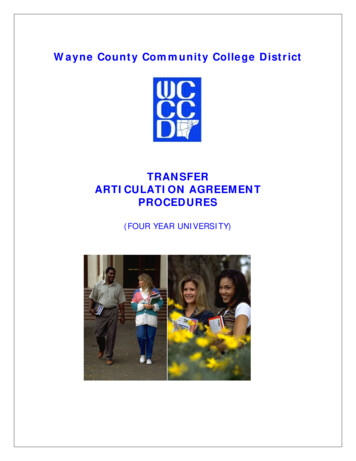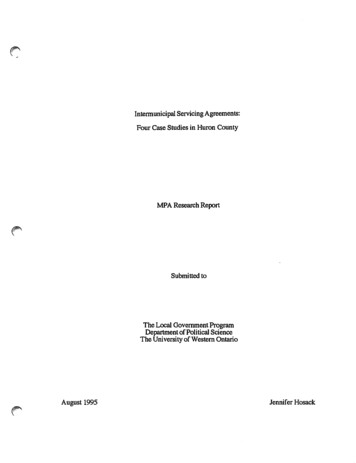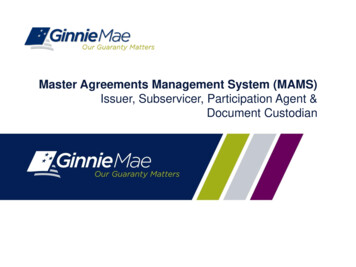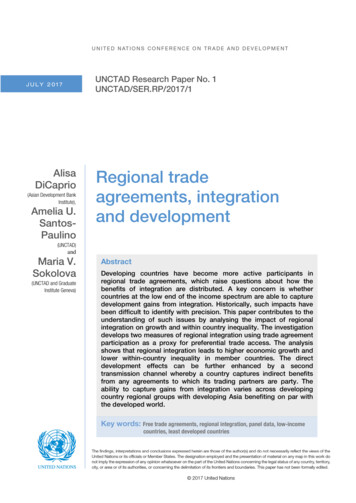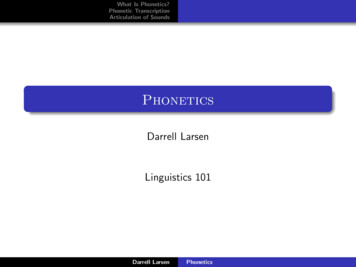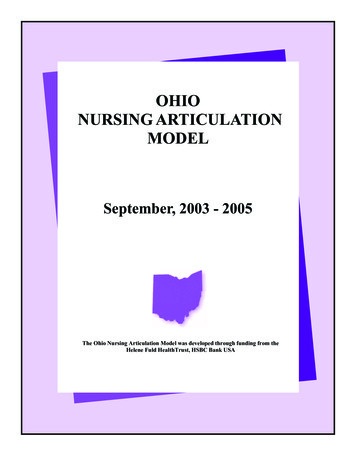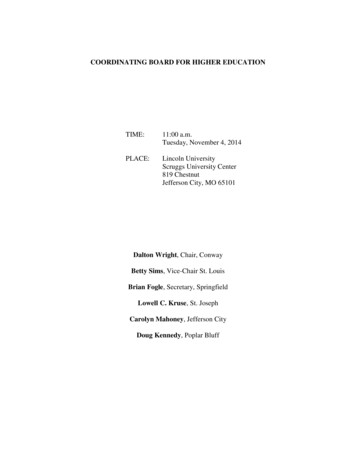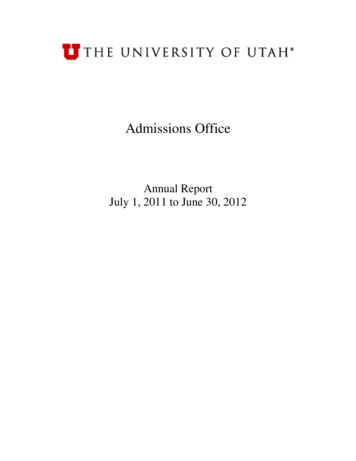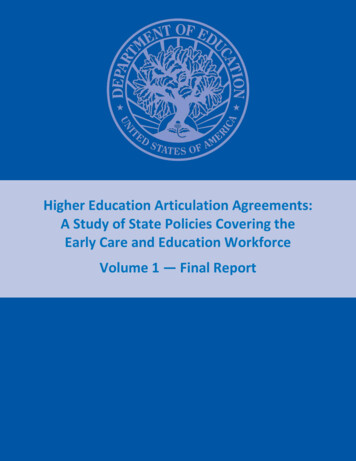
Transcription
Higher Education Articulation Agreements:A Study of State Policies Covering theEarly Care and Education WorkforceVolume 1 — Final Report
Higher Education Articulation Agreements:A Study of State Policies Covering theEarly Care and Education WorkforceVolume 1Prepared for:U.S. Department of EducationOffice of Planning, Evaluation and Policy DevelopmentPolicy and Program Studies ServicePrepared by:Aleksandra Holod, Andrea Boyle, Jennell McHugh, Alexa Cinque, and Candice HandjojoAmerican Institutes for Research2019
This report was produced under U.S. Department of Education Contract No. GS-00F-347CA/ED-PEP-16A-0004/TO02. Brian Fu served as the contracting officer’s representative. The views expressed herein donot necessarily represent the positions or policies of the Department of Education. No officialendorsement by the U.S. Department of Education of any product, commodity, service, or enterprisementioned in this publication is intended or should be inferred. For the reader’s convenience, thispublication contains information about and from outside organizations, including hyperlinks and URLs.Inclusion of such information does not constitute an endorsement by the Department.U.S. Department of EducationBetsy DeVosSecretaryOffice of Planning, Evaluation and Policy DevelopmentJames BlewAssistant SecretaryPolicy and Program Studies ServiceGregory FortelnyDirectorSeptember 2019This report is in the public domain. Authorization to reproduce it in whole or in part is granted. Whilepermission to reprint this publication is not necessary, the citation should be: U.S. Department ofEducation, Office of Planning, Evaluation and Policy Development, Policy and Program Studies Service,Higher Education Articulation Agreements: A Study of State Policies Covering the Early Care andEducation Workforce, Washington, D.C., 2019.This report is available on the Department’s website ss/reports.html.Availability of Alternate FormatsRequests for documents in alternate formats such as Braille or large print should be submitted to theAlternate Format Center by calling 202-260-0852 or by contacting the 504 coordinator via email atom eeos@ed.gov.Notice to Limited English Proficient PersonsIf you have difficulty understanding English, you may request language assistance services forDepartment information that is available to the public. These language assistance services are availablefree of charge. If you need more information about interpretation or translation services, please call 1800-USA-LEARN (1-800-872-5327) (TTY: 1-800-437-0833), or email us at:Ed.Language.Assistance@ed.gov. Or write to: U.S. Department of Education, Information ResourceCenter, LBJ Education Building, 400 Maryland Avenue SW, Washington, D.C. 20202.Content Contact:Brian FuPhone: 202-260-1467brian.fu@ed.gov
Higher Education Articulation Agreements:A Study of State Policies Covering the Early Care and Education WorkforceContentsList of Exhibits . vAcknowledgments . viiExecutive Summary . ixKey Findings . ixStudy Purpose . xMethodology and Study Limitations . xSummary of Findings . xiI. Introduction . 1Policy Context . 1Overview of Study Purpose and Design . 2Key Elements of Articulation. 3Study Methods and Limitations . 9Key Terms. 11II. Statewide Articulation and Transfer Policies . 13Transfer Associate’s Degrees and Guaranteed Admission . 13Common General Education Requirements . 15Common Course Numbering and Other Equivalency Systems . 16The Role of ECE Industry Standards . 17Other Statewide Transfer Policies . 19III. State-Level Governance and Oversight . 21Governance Structure: Articulation Oversight Committees and Agencies . 21Governance Process and Roles . 22Stakeholder Involvement . 25Developing Policies for Academic Alignment . 27IV. IHE-Level Implementation of Articulation Policies . 29IHE-Level Transfer and Articulation Policies . 29Implementation Roles and Supports . 33V. Transfer Supports for Students . 37Advising . 37Other Supports. 42Conclusion . 45References . 47iii
Higher Education Articulation Agreements:A Study of State Policies Covering the Early Care and Education WorkforceExhibitsExhibit 1.Elements of articulation: Governance . 3Exhibit 2.Elements of articulation: Academic policy . 4Exhibit 3.Elements of articulation: Articulation agreement provisions . 6Exhibit 4.Elements of articulation: Articulation and transfer supports . 7Exhibit 5.Elements of articulation: State context considerations . 8Exhibit 6.Characteristics of the case study states . 9Exhibit 7.States with transfer associate’s degrees and guaranteed admission . 13Exhibit 8.States with common general education requirements and course numberingsystems . 14Exhibit 9.States in which ECE industry standards played a role in statewide ECE articulationefforts . 17Exhibit 10.Primary type of governing body for statewide articulation efforts, by state . 21Exhibit 11.Roles and responsibilities of states’ primary articulation governing bodies, by state . 22Exhibit 12.Approaches to facilitating adherence to statewide articulation policies, by state . 23Exhibit 13.Types of stakeholders engaged in developing or overseeing statewide articulationefforts, by state . 26Exhibit 14.Methods for acquiring faculty stakeholder input, by state . 27Exhibit 15.Number of two-year and four-year IHEs that reported various articulation policiesand practices, by institution type . 30Exhibit 16.Number of two-year and four-year IHEs that reported various types of faculty andstaff roles in implementing articulation policies, by institution type . 33Exhibit 17.Number of two-year and four-year IHEs that reported providing various types ofadvising supports to students, by institution type . 38Exhibit 18.Number of two-year and four-year IHEs that reported strategies to increasestudents’ access to advising supports, by institution type . 40Exhibit 19.Number of states in which students reported challenges related to advisingsupports . 42Exhibit 20.Number of two-year and four-year IHEs that reported providing other transferrelated supports to students, by institution type . 43v
Higher Education Articulation Agreements:A Study of State Policies Covering the Early Care and Education WorkforceAcknowledgmentsWe wish to thank several individuals who contributed to the completion of this report. First, we wouldlike to thank the state higher education administrators, policy staff, faculty, staff, and students whoseparticipation made this study possible. We are grateful for the members of the Technical Working Group,who developed the elements of articulation that guided this study. We thank Brian Fu, Erica Lee, andStephanie Stullich of the Policy and Program Studies Service for their guidance and support. Kerstin LeFloch,Kelle Parsons, and Matt Soldner also made thoughtful contributions to the study design and the report.Although we appreciate the assistance and support of these individuals, any errors in judgment or factare the responsibility of the authors.vii
Higher Education Articulation Agreements:A Study of State Policies Covering the Early Care and Education WorkforceExecutive SummaryA barrier that students and mid-career professionals often face in attempts to advance their educationlevel is that the coursework completed and credits earned in one institution of higher education (IHE)may not transfer to another. As a result, students who seek to extend their education and qualificationsmay experience a loss of course credit and a disruption of degree progress when transferring betweentwo-year and four-year IHEs. These delays can then discourage or delay them from pursuing orcompleting a bachelor’s degree. Nationally, more than one third of community college students whotransfer to a four-year institution do not earn a bachelor’s degree within six years.Recognizing the credit loss that these students experience during the transfer process, some states havedeveloped articulation policies and agreements to facilitate the transfer of credits and courseworkbetween degree programs in different IHEs within the state. Articulation policies are a particularlyimportant issue for individuals who begin their higher education coursework in a two-year IHE and thenseek to transfer to a four-year IHE to obtain a bachelor’s degree, which often is the case for teachersand caregivers in the early childhood workforce. In some states, articulation policies and agreementsinclude specific provisions for degree programs related to early care and education (ECE).This report examines articulation policies and practices in six states with policies that include provisionsspecifically for ECE. The study involved telephone interviews and focus groups with state-level highereducation administrators and staff, as well as administrators, faculty, and students from 20 IHEs withinthe six states (including both two-year and four-year institutions). The examples and experiences ofthese states and IHEs may be applicable to other fields as well and may be useful for policymakers,higher education administrators, and faculty seeking to improve the efficacy of their broader articulationpolicies and practices.Key Findings All six states in the study used transfer associate’s degrees and general education blocktransfers, which allow students to transfer courses as a set rather than on a course-by-coursebasis, to facilitate course and credit transfer for ECE students; half of the states also usedguaranteed admission or common course numbering. Four states established at least one statewide committee to oversee articulation; the remainingtwo states oversaw articulation through a state higher education agency or system office. Most IHEs (17 of 20) supplemented state-level articulation policies with intrastate and interstateregional articulation agreements formed between IHEs. Most two-year IHEs (nine of 10) offered separate ECE degree pathways for students whoplanned to transfer and earn a bachelor’s degree versus students who planned to end theireducation with an associate’s degree. In nearly all IHEs (19 of 20), ECE faculty played several key roles in implementing articulationpolicies, such as evaluating course transferability (15 IHEs) and designing courses that reflectagreed-on competencies (12 IHEs). IHEs supported transfer students by providing online information about transfer (12 IHEs),transfer centers (six IHEs), outreach programs (six IHEs), and transfer student orientations(five IHEs).ix
Higher Education Articulation Agreements:A Study of State Policies Covering the Early Care and Education Workforce Faculty and staff advised students on topics including career paths (16 IHEs) and financial aid(15 IHEs), referred students to degree planning tools (14 IHEs), and referred students to transferadvisors (three IHEs).Study PurposeThe purpose of this descriptive study was to identify the articulation approaches that states have usedto facilitate higher education articulation for ECE professionals, allowing them to progress fromsubbaccalaureate coursework and credentials to an associate’s degree and then a bachelor’s degreewithout losing relevant coursework and credits. The study also examined implementation of articulationwithin states and IHEs. The study was designed to answer the following study questions:1. In the six states examined in this study, what higher education articulation policies and practiceshave been implemented to support students seeking a degree in ECE?2. What governance structures do these states have in place to oversee ECE articulation policy?How do the states involve stakeholders in policy development and oversight?3. How do IHEs in these states implement articulation policies?4. What supports do the states and IHEs provide for the transfer and articulation process?Methodology and Study LimitationsTo address these questions, the study team conducted case studies in a purposive sample of six statesand 20 IHEs that have statewide articulation policies that address ECE degree pathways. To identifystates for inclusion in the study, the study team reviewed extant documents to identify those states withstatewide articulation policies for students pursuing a degree in ECE. The team identified an initial list of11 states that met the study inclusion criteria and then narrowed the list to six states. Factorsconsidered in selecting the six states included types of articulation policies, geographic region, highereducation context, and ECE program context. States were selected to demonstrate a variety of statecontexts and articulation approaches. The final sample included California, Florida, Indiana,Massachusetts, New Mexico, and Pennsylvania.The study team selected 20 IHEs (10 two-year and 10 four-year) in the six states. The IHEs were selectedprimarily based on the number of ECE degrees granted, with the goal of ensuring at least one IHE wasselected from each public higher education system within each state. This approach to IHE selectionallowed the study team to examine cross-system articulation and transfer. Other criteria consideredincluded the presence of a staff person, faculty member, or administrator who was involved in creatingor overseeing statewide ECE articulation policy. In states with public Historically Black Colleges andUniversities or minority-serving institutions that offered ECE degree programs, the study teamendeavored to include at least one of those institutions in the study.Data collection took place between February 2018 and July 2018. Interviews were conducted at the statelevel with representatives from state higher education executive offices, state higher educationagencies, and state higher education system offices; state legislative analysts or policy staff; andrepresentatives from articulation oversight committees. At IHEs, interviews were conducted with senioracademic administrators and faculty. In addition, focus groups were conducted with IHE staff (such asregistrars, student advisors, and financial aid officers) and with students. The study team coded the interviewand focus group transcripts and information from extant documents to identify themes and verify evidencethat emerged across the sites.x
Higher Education Articulation Agreements:A Study of State Policies Covering the Early Care and Education WorkforceReaders should note some limitations to the interpretation and generalizability of the study findings.The six states were not nationally representative, and data should not be generalized to other states.Moreover, the IHEs selected may not be representative of all IHEs in each state, and findings for ECEmay not generalize to other higher education disciplines or fields. Findings from the interviews and focusgroups were based on self-reports of the specific individuals participating in the study and might notrepresent the views of other administrators, faculty, staff, students, and stakeholders in these states.Summary of FindingsStatewide Articulation and Transfer PoliciesAll six states in the study used transfer associate’s degrees and general education blocktransfers to facilitate course and credit transfer for ECE students; half of the states also usedguaranteed admission or common course numbering.More specifically, all six states instituted transfer associate’s degrees in ECE that allow students totransfer their lower division coursework as a block and enroll in a four-year degree program with juniorstatus. All six states established common general education requirements that allow for block transfer of30–35 credits. These common requirements reflected a shared understanding between two-year andfour-year IHEs regarding the content, competencies, and learning outcomes expected of all first- andsecond-year students. Three states offered guaranteed or priority admission into a public four-year IHEs forstudents who earned transfer associate’s degrees. Requirements for guaranteed admission included aminimum grade point average, minimum grades for specified courses, and passing scores on teacherlicensure examinations prior to admission. Three states implemented common course numberingsystems, which assigned common course numbers for equivalent courses at participating IHEs. Thesesystems allowed faculty, staff, and students to track which courses would transfer and how they wouldfulfill degree requirements.State-Level Governance and OversightFour of the states established at least one statewide committee to oversee articulation; theremaining two states oversaw articulation through a state higher education agency or system office.In four states, articulation was governed by a statewide committee appointed by a higher educationexecutive officer or a state higher education coordinating board. In three of the four states with anoversight committee, the committee had an active, ongoing role in monitoring, updating, and enforcingthe statewide policy after the policy was developed. In the remaining two states, articulation policy wasoverseen by a state higher education agency or system offices, and individual colleges and universitieshad more discretion in determining how articulation would be implemented.IHE-Level Implementation of Articulation PoliciesMost of the IHEs in the study (17 of 20) supplemented state-level articulation policies withintrastate and interstate regional articulation agreements formed between IHEs.Even with the existence of statewide articulation policies, nearly all IHEs continued to use regionalagreements to supplement state-level articulation policies. Agreements between four-year IHEs andtheir two-year feeder institutions served to clarify how courses from a two-year IHE would transfer,xi
Higher Education Articulation Agreements:A Study of State Policies Covering the Early Care and Education Workforceoffer additional transfer benefits beyond those required under state-level policies, or extend transferbenefits to students not covered under state-level policies.Most two-year IHEs (nine of 10) offered separate ECE degree pathways for students who planned totransfer and students who planned to end their education with an associate’s degree.ECE students at nearly all the community colleges had to choose from two or more degree options,depending on their goals for educational attainment. Generally, these options included transferassociate’s degrees for students who planned to transfer plus other terminal associate’s degrees thattrained students for work in the ECE field immediately after graduation. Students who earned theterminal associate’s degree and later decided to pursue a four-year degree often reported encounteringmisalignment and loss of credits after enrolling in a bachelor’s degree program.In nearly all of the IHEs (19 of 20), ECE faculty played key roles in implementing articulationpolicies, such as evaluating course transferability (15 IHEs) and designing courses thatreflected agreed-on competencies (12 IHEs).ECE faculty members — with their expertise in both the content and structure of their school’s ECEcoursework — were largely responsible for determining whether and how courses from other IHEswould transfer. To evaluate a course’s transferability, faculty members reviewed syllabi, examples ofstudent work from the course, and/or qualifications of the person who taught the course. ECE facultyalso played a lead role in designing courses that reflected the skills and competencies outlined instatewide or locally agreed-on curricular frameworks.Transfer Supports for StudentsIHEs supported transfer students by providing online information about transfer (12 IHEs), transfercenters (six IHEs), outreach programs (six IHEs), and transfer student orientations (five IHEs).Twelve of the 20 IHEs provided transfer information on their websites or through referral to statewidetransfer websites. Six IHEs reported that their transfer centers provided prospective transfer students withinformation regarding coursework, degree requirements, scholarship information, and transfer timelines.Six of the four-year IHEs described sending representatives to two-year IHEs to meet with faculty, staffadvisors, and prospective transfer students. In addition, several four-year IHEs offered orientations to helptransfer students acclimate to their new campus and plan upper division course sequences.Faculty and staff advised students on topics including career paths (16 IHEs) and financial aid(15 IHEs), referred students to degree planning tools (14 IHEs), and referred students totransfer advisors (three IHEs).Faculty and staff at most IHEs advised students on career paths, degree options, and financial aid. Lessfrequently, faculty and staff advised students on the transfer process. They also referred prospectivetransfer students to degree planning tools, such as degree maps and transfer guides, or to transferspecific advisors. Despite these resources, students reported receiving inaccurate or insufficientguidance from advisors about the transfer process and financial aid.xii
Higher Education Articulation Agreements:A Study of State Policies Covering the Early Care and Education WorkforceI. IntroductionA barrier that students and mid-career professionals often face in attempts to advance their educationlevel is that the coursework completed and credits earned in one institution of higher education (IHE)may not transfer to another. To address this issue, states have developed a variety of articulationpolicies and agreements to facilitate the transfer of credits between degree programs. Articulationpolicies are particularly important for individuals who begin their higher education coursework in a twoyear college and later seek to transfer their credits to obtain a bachelor’s degree, which often is the casefor teachers and caregivers in the early childhood education and care workforce. This study provides anin-depth examination of how six states and their IHEs have implemented articulation policies thatinclude provisions specific to the early childhood field, including approaches to articulation, governancestructures, roles played by various stakeholders, and supports provided to transfer students.Policy ContextIHEs offer multiple pathways for pursuing postsecondary credentials and degrees. Although somestudents begin and end their postsecondary education in a four-year college or university, others mayseek a two-year associate’s degree and then enter the workforce, and still others may begin in a communitycollege with the intention of transferring to a four-year institution. In fact, about one third of all collegestudents are enrolled in a public, two-year community college (Ginder, Kelly-Reid, and Mann 2019).Furthermore, approximately half of all students who complete a bachelor’s degree previously enrolled ina public, two-year community college (National Student Clearinghouse Research Center 2017).Individuals’ education and career plans often change across time, and graduates who earn an associate’sdegree may decide to continue their education to increase their qualifications and skills (and potentiallyearn a higher salary), often at a different IHE than the one that conferred their associate’s degree.Whether seeking to make this transition mid-education or mid-career, such students often face barriersbecause of differing coursework requirements between degree programs and institutions. Courseworkcompleted and credits earned at one IHE may not transfer to another; in particular, students whotransfer between two-year and four-year IHEs may experience a loss of course credit and a disruption ofdegree progress (Jenkins and Fink 2015; Limardo, Sweeney, and Taylor 2016). On average, only60 percent of transfer students nationally have been able to transfer most or all of their credits, whereas15 percent were granted almost no transfer credit (Monaghan and Attewell 2015).These challenges can increase the cost and effort required to obtain a bachelor’s degree, as well asdiscouraging some candidates from pursuing or completing a degree. Nationally, more than one third ofcommunity college students who transfer do not earn a bachelor’s degree within six years (Jenkins andFink 2015). Moreover, students who lost half or more of their credits were significantly less likely to earna bachelor’s degree compared with students who were able to transfer most of their credits (Monaghanand Attewell 2015).To address these challenges, states have developed a variety of articulation policies and agreements tofacilitate the transfer of credits and coursework between degree programs. The National Conference ofState Legislatures (2013) found that all 50 states had one or more articulation policies. Thirty states hadcommon course numbering systems across participating IHEs, 40 states had identified a generaleducation core accepted across institutions, and 45 states had transfer associate’s degrees that allowstudents to block transfer their lower division coursework and enroll in a four-year degree program with1
Higher Education Articulation Agreements:A Study of State Policies Covering the Early Care and Education Workforcejunior status. Twenty-eight states enacted legislation to adopt such policies, whereas others had policiesthat were adopted by IHE boards or state agencies. In some cases, networks of institutions entered intovoluntary agreements to fa
Four states established at least one statewide committee to oversee articulation; the remaining two states oversaw articulation through a state higher education agency or system office. Most IHEs (17 of 20) supplemented state-level articulation policies with intrastate and interstate regional articulation agreements formed between IHEs
